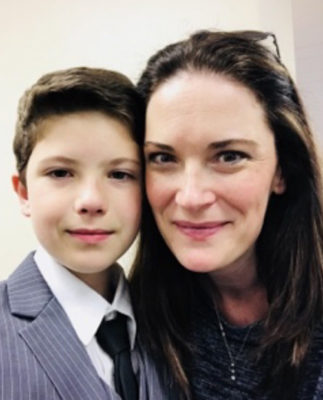Big Footprints, Bad Step

Mykell, an athletic trainer, is super active, running bleachers, going to the gym five days a week, riding bikes, and entering fitness competitions, all without an injury. She took her stepson, niece and nephew to the trail of dinosaurs to walk beside the giant footprints imprinted in a riverbed close to Austin. Scientists believe that the three-toed prints may be from a carnivore, the Acrocanthosaurus. The Brontosaurus may have made other big circular tracks 100 million years ago. Walking along the trail of dino footprints, Mykell stepped wrong on the uneven ground and twisted something in her knee. She continued her workouts for two weeks until she was unable to walk. Since she became completely immobile on a Sunday, she was pleasantly surprised to have immediate access to an orthopedic surgeon at DOC.
“Everyone was personable and made me feel comfortable, the MA, RoxAnn, and the surgeon, Dr. Chris Hall. After X-rays and an MRI, I was diagnosed with left knee medial femoral chondyle osteochondral lesion.”
The patella (kneecap) is a small bone located in front of the knee joint, where the thighbone (femur) and shinbone (tibia) meet. Articular cartilage lubricates the knee joint for movement. A knee injury, a stress fracture or dislocation, caused by trauma to the knee can damage blood vessels and reduce blood flow to the femur. Osteonecrosis most often occurs in the knobby portion of the femur on the inside of the knee, medial femoral condyle, when the blood supply to a section of bone in the femur is disrupted. Bone cells need a steady supply of blood to stay healthy. The first symptom is pain on the inside of the knee followed by difficulty standing, putting weight on the affected knee, or moving the knee joint. Mykell suffered first with knee pain and two weeks later could not walk. Treatment almost always involves surgery to prevent further damage to the bone and improve function in the joint.
“My experience was amazing from the first appointment, during, and after surgery. While I was in surgery, Dr. Hall injected both knees with stem cells and PRP to promote bone and cartilage healing. After surgery, I did not take any pain medication at all. Both Dr. Hall and RoxAnn have texted and called me to check on my recovery. My knee joint is way ahead of range of motion expectations. I’m engaging in mild therapy, swimming and biking, but no high-impact activities,” Mykell explains.
Mykell will walk on the wild side again soon, running bleachers or tracing the tracks of the dinosaurs. In the meantime, she is six weeks into her recovery and enjoying accelerated healing from immediate, expert orthopedic care at DOC and the power of regenerative medicine.
For more information on the cost of care, click here.



